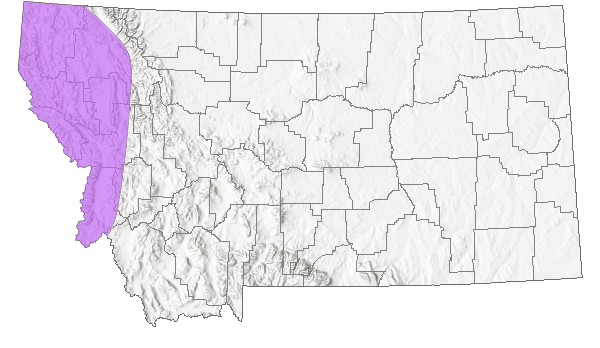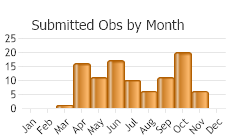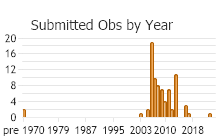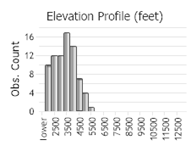View in other NatureServe Network Field Guides
NatureServe
Montana
Utah
Wyoming
Idaho
Wisconsin
British Columbia
South Carolina
Yukon
California
New York
Idaho Forestsnail - Allogona ptychophora
Other Names:
Helix townsendiana, Helix ptychophora, Mesodon ptychophorus, Polygyra townsendiana, Polygyra ptycghophora.
Native Species
Global Rank:
G5
State Rank:
S5
Agency Status
USFWS:
USFS:
BLM:
External Links
General Description
A large shell, to 24 mm in diameter and 15 mm in height, heliciform with up to 5 3/4 whorls. Shell is opaque and covered with a light brown chitinous layer (periostracum) that is never “hairy” and becomes worn away with age; shell also with fine incremental striae lighter in color and wrinkle-like axial riblets extending to the undersurface. Very fine wavy spiral striae present throughout the shell. The last whorl is slightly contracted behind the aperture lip, which is reflected, white, and slightly thickened near the base with a slightly bulging callus; aperture is oval, not rounded, the base partly obscuring the umbilicus, which is deep but very narrow (Hendricks 2012, Burke 2013). Internal anatomy is described by Pilsbry (1940).
Subspecies present in Montana is A. p. ptychophora.
Diagnostic Characteristics
Mature individuals differ from other species in Montana by a combination of shape and medium to large size, absence of spiral bands, presence of a flared or reflected lip around the aperture, umbilicus partially covered by aperture lip, and lack of any teeth, the last which separates Allogona from Cryptomastix.
Species Range
Montana Range
Range Descriptions

 Native
Native
Range Comments
British Columbia to Oregon through western Montana (Burke 2013). In Montana, reported from six counties west of the Continental Divide and abutting Idaho: Lake, Lincoln, Mineral, Missoula, Ravalli, Sanders. Elevation range is 777 to 1747 m (2550 to 5730 ft). Can be locally abundant; 164 reported were at one site in Missoula County in October (Hendricks 2012).
Observations in Montana Natural Heritage Program Database
Number of Observations: 100
(Click on the following maps and charts to see full sized version)
Map Help and Descriptions
Relative Density

Recency



 (Observations spanning multiple months or years are excluded from time charts)
(Observations spanning multiple months or years are excluded from time charts)
Habitat
Mesic mixed conifer forest, often near water such as stream-side riparian, and seeps, but sometimes well away from surface water. Canopy species include western redcedar, western hemlock, Engelmann spruce, Douglas-fir, grand fir, western larch, ponderosa pine, lodgepole pine, black cottonwood, aspen and paper birch; secondary canopy includes alder, willow, dogwood, and mountain maple. Found most often under woody debris or rocks in leaf litter and duff, sometimes on the surface and in the open (Hendricks 2012).
Ecology
The winter survival of hibernating individuals is related to the orientation of the shell; those with the aperture pointed up rather than against the ground have a reduced probability of mortality for unknown reasons (Carney 1966).
References
- Literature Cited AboveLegend:
 View Online Publication
View Online Publication Burke, T. E. 2013. Land snails and slugs of the Pacific Northwest. Corvallis, OR: Oregon State University Press. 344 p.
Burke, T. E. 2013. Land snails and slugs of the Pacific Northwest. Corvallis, OR: Oregon State University Press. 344 p. Carney, W.P. 1966. Mortality and apertural orientation in Allogona ptychophora during winter hibernation in Montana. The Nautilus 79:134-136.
Carney, W.P. 1966. Mortality and apertural orientation in Allogona ptychophora during winter hibernation in Montana. The Nautilus 79:134-136. Hendricks, P. 2012. A Guide to the Land Snails and Slugs of Montana. A report to the U.S. Forest Service - Region 1. Montana Natural Heritage Program, Helena, MT. vii + 187 pp. plus appendices.
Hendricks, P. 2012. A Guide to the Land Snails and Slugs of Montana. A report to the U.S. Forest Service - Region 1. Montana Natural Heritage Program, Helena, MT. vii + 187 pp. plus appendices. Pilsbry, H.A. 1940. Land Mollusca of North America (north of Mexico), Volume 1 Part 2. Monograph of the Academy of Natural Sciences of Philadelphia Monograph Number 3(1): 574-994.
Pilsbry, H.A. 1940. Land Mollusca of North America (north of Mexico), Volume 1 Part 2. Monograph of the Academy of Natural Sciences of Philadelphia Monograph Number 3(1): 574-994.
- Additional ReferencesLegend:
 View Online Publication
View Online Publication
Do you know of a citation we're missing? Elrod, M.J. 1902. Daphnia pond, a study in environment. University of Montana Bulletin #16, Biological Series 5: 230-233.
Elrod, M.J. 1902. Daphnia pond, a study in environment. University of Montana Bulletin #16, Biological Series 5: 230-233. Forsyth, R.G. 2004. Land snails of British Columbia. Royal British Columbia Museum: Victoria, British Columbia, Canada. 188 pp.
Forsyth, R.G. 2004. Land snails of British Columbia. Royal British Columbia Museum: Victoria, British Columbia, Canada. 188 pp. Frest, T.J. and E.J. Johannes. 2001. An annotated checklist of Idaho land and freshwater mollusks. Journal of the Idaho Academy of Science 36(2):1-51.
Frest, T.J. and E.J. Johannes. 2001. An annotated checklist of Idaho land and freshwater mollusks. Journal of the Idaho Academy of Science 36(2):1-51. Hendricks, P. 2005. Surveys for animal species of concern in northwestern Montana. Unpublished report to the Montana Department of Fish, Wildlife & Parks, Montana Natural Heritage Program, Helena, Montana, May 2005. 53 p.
Hendricks, P. 2005. Surveys for animal species of concern in northwestern Montana. Unpublished report to the Montana Department of Fish, Wildlife & Parks, Montana Natural Heritage Program, Helena, Montana, May 2005. 53 p. Illich, P.M. 1966. The dispersion and activity of the terrestrial gastropod, Allogona ptychophora (A. D. Brown), in relation to its microhabitat. Master’s Thesis, University of Montana, Missoula, MT. 88 pp.
Illich, P.M. 1966. The dispersion and activity of the terrestrial gastropod, Allogona ptychophora (A. D. Brown), in relation to its microhabitat. Master’s Thesis, University of Montana, Missoula, MT. 88 pp. Smith, A.G. 1943. Mollusks of the Clearwater Mountains, Idaho. Proceedings of the California Academy of Sciences, fourth series, 23:537-554.
Smith, A.G. 1943. Mollusks of the Clearwater Mountains, Idaho. Proceedings of the California Academy of Sciences, fourth series, 23:537-554. Stabins, H. 2004. Forest owl and invertebrate monitoring report for northwestern Montana Plum Creek managed landscapes for 2003 and 2004. Plum Creek.
Stabins, H. 2004. Forest owl and invertebrate monitoring report for northwestern Montana Plum Creek managed landscapes for 2003 and 2004. Plum Creek. Vanatta, E.G. 1914. Montana shells. Proceedings of the Academy of Natural Sciences of Philadelphia 66:367-371.
Vanatta, E.G. 1914. Montana shells. Proceedings of the Academy of Natural Sciences of Philadelphia 66:367-371.
- Web Search Engines for Articles on "Idaho Forestsnail"
- Additional Sources of Information Related to "Snails / Slugs"





